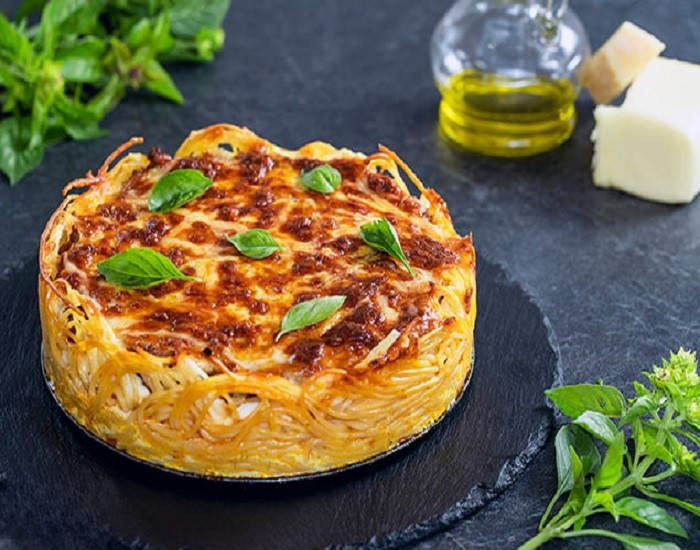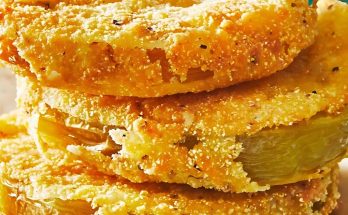This Spaghetti Pie recipe is a revelation, a culinary mashup that transforms pantry staples into a show stopping dish.
Ingredients
- 1 cup of cooked spaghetti pasta
- 1 beaten egg
- 1 tablespoon of olive oil
- 1 cup of grated parmesan cheese
- 1 1/2 cup of ricotta cheese
- 1 cup of shredded mozzarella cheese
- 1/4 cup of marinara sauce
- 1/4 cup of chopped parsley
- 1/4 teaspoon of oregano
- 1/4 teaspoon of garlic powder
- 1/2 teaspoon of salt
- 1/4 teaspoon of black pepper
Directions
- Preheat the oven to 375 °F (190 °C).
- In a large bowl, combine cooked spaghetti, Parmesan cheese, parsley, oregano, garlic powder, salt, and pepper. Toss until well coated. Drizzle with olive oil and mix again.
- Spread the mixture evenly in the bottom of a greased 9×13 inch baking dish, pressing down to form a firm crust.
- Bake for 10 minutes, or until golden brown and crispy.
- In a separate bowl, combine ricotta cheese, mozzarella cheese, Parmesan cheese, egg, marinara sauce, salt, and pepper. Mix until smooth and creamy. Pour the filling over the pre-baked crust, spreading evenly.
- Sprinkle the top of the pie with mozzarella cheese and Parmesan cheese. Bake for 20-25 minutes, or until the filling is set and bubbly, and the cheese is melted and golden brown.
- Let the Spaghetti Pie cool for 10 minutes before slicing and serving.

Tips
- Use any type of cooked pasta will work, but longer strands like spaghetti are ideal for building the crust. For more, check out our ‘Types of Pastas’ article.
- Feel free to experiment with different cheese combinations in the filling. Gruyère, cheddar, or provolone can all add interesting flavors.
- This recipe can be easily adapted with different cheeses and fillings. Try using feta cheese and crumbled sausage for a Greek twist, or swap the ricotta for cottage cheese for a lighter option. For more, check out our ‘Types of Cheeses’ article.
- Don’t over-bake the crust, or it will become too hard. Ten minutes should be enough to achieve a nice golden brown and crispy texture.
- Leftover Spaghetti Pie can be stored in the refrigerator for up to 3 days. Reheat in the oven at 350 °F (175 °C) until warmed through.
- Feel free to get creative with the toppings! Sprinkle with fresh herbs, add a drizzle of hot sauce, or serve with a side of garlic bread for an extra decadent treat.
- Sprinkle some chili flakes or red pepper flakes on top before baking for a touch of heat.
- Garnish with chopped fresh basil or oregano for a burst of flavor right before serving.
This Spaghetti Pie recipe is tender pasta dish nestled in a cheesy ricotta, all wrapped in a crispy, parmesan-infused crust. Whether you’re a pasta enthusiast or simply looking for a cozy and delicious meal, Spaghetti Pie is a delightful option.
Spaghetti Pie tantalize your taste buds with layers of pasta intermingle with savory sauce and a cheesy topping, creating a harmonious blend of textures and flavors.

Equipment for this recipe
Origins of Spaghetti Pie
Spaghetti Pie, with its roots deeply embedded in American home kitchens, emerged as a creative solution to reinvent leftover spaghetti. Its exact origins remain unclear, but the dish gained popularity in the mid-20th century, reflecting the era’s fascination with inventive and convenient recipes.
The basic concept involves taking leftover or freshly cooked spaghetti, combining it with eggs and cheese to create a sturdy base, and then layering it with various ingredients like meat, vegetables, or sauce. The mixture is baked until it sets into a pie-like form, complete with a golden, cheesy crust.
While Spaghetti Pie might not have a specific origin story akin to traditional dishes, it showcases the adaptability and resourcefulness of home cooks. Its evolution likely stemmed from the desire to turn ordinary leftovers into something new and exciting, embodying the spirit of American ingenuity in the kitchen.
Can Spaghetti Pie Be Made-Ahead?
Make-Ahead Instructions:
Assemble Ahead: You can assemble the Spaghetti Pie completely (crust, filling, and topping) and refrigerate it for up to 24 hours before baking. This is a great way to save time on the day of serving.
Partial Assembly: If you prefer, you can make the crust and filling separately and store them in the refrigerator for up to 24 hours. Assemble and bake the pie when ready to serve.
How To Freeze Spaghetti Pie?
Unbaked Pie:
- Assemble the pie completely as directed, but do not bake it.
- Cover the pie tightly with plastic wrap and then aluminum foil.
- Freeze for up to 3 months.
- When ready to bake, thaw the pie in the refrigerator overnight.
- Remove the plastic wrap and bake at 375°F for 40-45 minutes, or until golden brown and bubbly.
Baked Leftovers:
- Cut leftover pie into individual slices.
- Wrap each slice tightly in plastic wrap and then aluminum foil.
- Freeze for up to 3 months.
- To reheat, thaw individual slices in the refrigerator overnight.
- Bake in a preheated 350 °F (175 °C) oven for 15-20 minutes, or until warmed through.
Variations
The beauty of the Spaghetti Pie lies in its versatility! Here are some variations:
Crust Twists:
- Cauliflower Crust: Replace half the cooked spaghetti with mashed cauliflower for a low-carb option.
- Whole Wheat Crunch: Swap regular spaghetti for whole-wheat spaghetti for a nutty flavor and extra fiber.
- Herb Explosion: Add chopped fresh herbs like thyme, rosemary, or basil to the crust for a flavor boost.
- Spicy Kick: Sprinkle crushed red pepper flakes or chili flakes into the crust for a touch of heat.
Filling:
- Meat: Add cooked sausage, ground beef, or shredded chicken to the filling for a heartier meal.
- Veggie: Sauteed spinach, mushrooms, or bell peppers make delicious additions to the creamy ricotta filling.
- White Sauce: Swap marinara sauce for pesto or creamy Alfredo sauce for a different flavor profile.
- Ricotta: Try using cottage cheese, mascarpone, or even goat cheese for a change of texture and tang.
Topping:
- Vegan: Use vegan ricotta cheese and mozzarella for a plant-based version.
- Caramelized Onion: Top the pie with caramelized onions for a sweet and savory topping.
- Breadcrumb: Sprinkle a mixture of panko breadcrumbs and Parmesan cheese on top before baking for extra crunch.
- Fresh Herb: Garnish with chopped fresh basil, oregano, or parsley after baking for a vibrant pop of color and flavor.
Remember, these are just a few ideas to get you started! Don’t be afraid to experiment and find your own favorite Spaghetti Pie combinations.
Wine & Dine
Choosing the perfect wine for Spaghetti Pie depends on the specific flavors you’ve emphasized in your creation. Here are some recommendations based on different directions you might have taken:
Classic Tomato & Cheese:
- Sangiovese: This Italian red offers medium body, bright acidity, and subtle fruit notes that stand up to the tomato sauce and complement the cheesiness. Look for a Chianti or Rosso di Montalcino.
- Montepulciano d’Abruzzo: Another Italian option, this versatile white grape provides crisp acidity and floral aromas that cut through the richness of the dish.
- Pinot Noir: If you prefer a lighter red, a Pinot Noir from Oregon or Burgundy can work well with its earthy notes and subtle fruit flavors.
Spicy Twist:
- Zinfandel: This bold Californian red can handle the heat with its juicy fruit and peppery spice.
- Grenache: A Spanish or French Grenache offers medium body and ripe fruit flavors with a touch of earthiness, balancing the spice without overpowering the dish.
- Rosé: A dry, crisp rosé can be a refreshing choice, especially if you’ve used lighter herbs in the filling.
Vegetable Delight:
- Sauvignon Blanc: This crisp white grape provides vibrant acidity and citrus notes that enhance the freshness of vegetables like spinach or peppers.
- Vermentino: Another Italian white, Vermentino offers floral aromas and minerality that pair well with savory vegetables and creamy ricotta.
- Pinot Grigio: If you prefer a slightly richer white, Pinot Grigio can work well with its roundness and stone fruit flavors.
Remember: Ultimately, the best wine is the one you enjoy!






